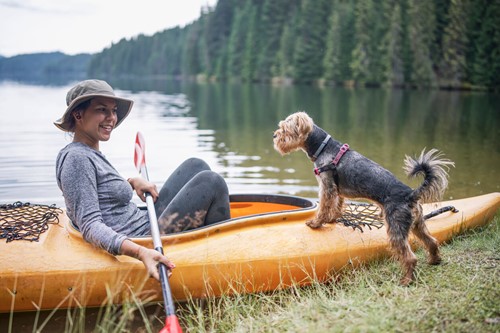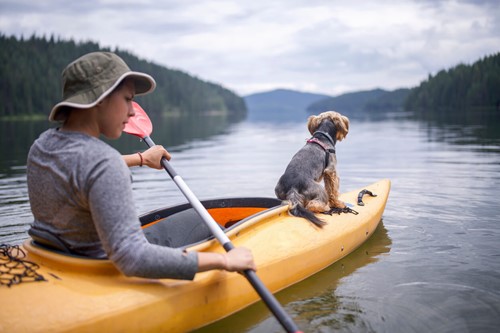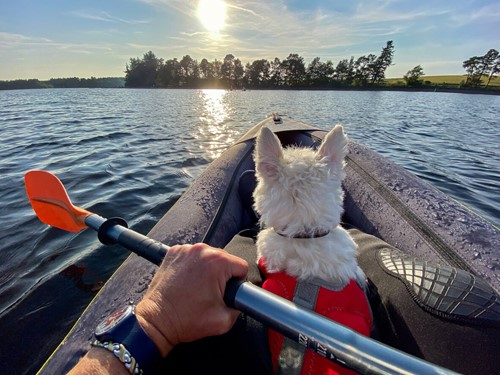So, you’ve fallen in love with kayaking and want to share the experience with your furry friend.
But taking your dog aboard your kayak can be intimidating if you don’t know where to start. There’s training to consider, alongside finding the right location and extra gear you’ll need to keep your pet safe.
Here’s our complete guide on how to go kayaking with your dog, so you can venture out on the water together and make some brilliant memories.
Training your dog for kayaking

1. Ensure your dog is ready for kayaking
The best chance of a positive experience whilst kayaking with your dog relies on their ability to join you on the water in the first place.
Unless your dog is well-trained and already accustomed to water, you should dedicate some time to building their confidence and assessing whether kayaking is a good idea for them.
Some dogs are bred to enjoy water-related activities and take to them immediately, while others are anxious or have trouble obeying commands.
Your dog’s well-being should be your priority, and you should only take them out on the water if you know they’re likely to enjoy it.
They don’t have to be a strong swimmer, and even the most obedient dogs can get distracted sometimes—but having skills in these areas certainly helps.
Related: What to wear for kayaking: a complete guide
2. Familiarise your dog with the kayak
Once you know your dog is comfortable with water, you can begin familiarising them with the kayak.
It’s best to do this at home, either in your garden or indoors, as this gives your dog a chance to get used to the boat in a familiar environment. Once it has its scent, they’ll find getting on it in the water less intimidating.
You could use treats or their favourite toys as incentives to get into or onto the kayak (depending on the type) and to reinforce the idea that it is something positive and fun.
Forcing your dog straight out onto the water could intimidate them and discourage them from wanting to participate in future.
3. Teach your dog helpful commands
Proper training is crucial if you want to go kayaking with your dog. You don’t want them jumping overboard to reach wildlife or getting confused if the boat capsizes.
The best way to ensure your dog feels confident is to develop a routine for getting in and out and teach them helpful commands that prepare them for any situation that could arise.
Here are some ideas:
- “get in/get out”—signals when your dog should enter or exit the kayak
- “get in your place”—redirects your dog’s energy if they become distracted
- “lay down”—signals when your dog should lie down, such as during waves or rough water
- “leave it!”—useful for intense situations when a distraction, such as wildlife or other boats, tempts your dog
Remember, your dog shouldn’t get in or out of the kayak without hearing a command from you.
This establishes authority and keeps them out of danger, as it teaches them not to head into the water alone.
4. Put the training to the test
After teaching your dog the basics and getting them used to the kayak at home, it’s time to put what they’ve learned to the test.
Head to some shallow water, whether at a beach or an inland waterway and practice getting in and out of the kayak first.
As we mentioned earlier, you may find it helpful to use a routine for getting in and out, as this can give your dog familiarity and help them build their confidence.
You should also develop a routine for the worst-case scenarios, like if you capsize together.
Don’t worry—you don’t need to push them overboard—decide whether you want to teach your dog to get into the boat before or after you, and practice this in the shallows to ensure your dog is prepared for every situation.
Once your dog is comfortable inside the kayak on the water, try pushing off.
Don’t scold them if they jump off right away, as lots of dogs do this during this stage—call them back onto the kayak and praise them when they get back on.
Each dog is different. Some will take to kayaking straight away. Others may need a few practice runs before you can push off into deeper water.
The key is to be patient. Always reward them for good behaviour and progress and know when to call it a day if they feel uncomfortable.
Related: The best places to kayak in the UK
5. Head out on the water
Once your pup has aced their initial training, it’s time to take a longer ride together. This is where the fun begins, and your hard work pays off.
Remember to accept that you might take a few steps back before you leap forward into properly kayaking with your dog. Many variables, such as weather conditions and wildlife, affect how a single session goes in the early days, so don’t expect too much too soon.
You might want to set out early and head to a location you know isn’t overly busy to get your dog used to kayaking without too many distractions.
6. Know how to handle them jumping out
If we had to give a bonus tip for kayaking with your dog, it would be to have a go-to action plan if your dog decides to jump ship. It should look something like this:
- remain calm as you paddle towards them, and give them a firm “get in”
- if they’re distracted by something, pull out a treat to coax them back towards you, and repeat the command if needed
- once you’re close enough, grab the strap of their PFD (personal floatation device) and pull them into the kayak
- don’t scold them once they’re back onboard—reward them instead, as this helps to reinforce the idea that good things happen when they come back!
Choosing the right location


The great thing about kayaking with your dog is that you can pretty much venture anywhere together.
That said, if your dog is new to being out on the water, choosing somewhere calm and quiet with minimal distractions is a good idea.
A peaceful lake or bay on a clear day is the ideal setting, especially if it’s somewhere easy for your dog to swim to shore.
White water kayaking is best avoided with dogs, even if your furry friend is a strong swimmer and loves being outdoors. Large waves or rapids present a higher risk of capsizing and could be dangerous for dogs to get caught in.
Best kayaks for dogs
Since dogs vary in size and you also have your preferences to consider, there are many options to choose from.
However, opting for a tandem kayak or a single-person model with ample space to maximise your and your pet’s comfort onboard is generally better.
Some of the best on the market include:
- Sea Eagle 370 inflatable tandem kayak—great value and has a capacity of 300kg
- Intex Explorer inflatable tandem kayak—extremely budget-friendly and has a capacity of 180kg
- Cambridge Kayaks Neptune solo sit-on-top model—simple with great stability and has a capacity of 135kg
- Wave Sport Scooter X solo sit-on-top kayak—exceptionally stable and sleek with a capacity of 150kg
There are many other options, but this gives you a head start.
Solo kayaks have less space but are more compact and could be better suited for smaller or anxious dogs wanting to cuddle up to you.
Tandem models have more space for larger dogs to spread out but tend to be less ‘sporty’ (but kayaking with your dog shouldn’t be a hugely fast-paced activity).
Plastic kayaks have the benefit of not being vulnerable to punctures but are sometimes less spacious than inflatable models, which are typically larger and more open.
It’s a good idea to scour the market and find something that suits both you and your dog and the amount of gear you need onboard.
Related: 7 best life vests for kayaking
Essential dog kayaking gear

The excitement of kayaking with your dog can mean overlooking some of the essential items you need to have onboard. But don’t worry, here’s a complete list of essentials so you can get prepared:
- PFD—you can find a range of PFDs for dogs online, most of which come with an integrated handle so you can easily lift your pup back onto your kayak if they need help
- Sun block—protect your pet from sunburn with suncream designed for dogs (make sure it’s waterproof)
- Fresh water and a bowl—it’s important to keep your dog hydrated with fresh drinking water
- Treats—these are great for reassuring or distracting your dog on your adventures together
- Food—if you’re out for the day, you’ll want to bring along their food so they can refuel
- Toys—water-friendly toys could improve your dog’s kayaking experience if they like to swim, and they’re also great for comforting them
- Dog poo bags—one of the easiest items to overlook (you’ll thank us later)
- A towel or blanket—this gives your dog somewhere comfortable to sit and helps them dry off
- Lead and harness—collars can be dangerous in the water in case they get caught on something, but a lead and harness are good to remember for when you’re back on land
- Basic first aid kit—medical supplies for both you and your pet are essential, including bandages and waterproof plasters to treat any small injuries to paws
Having a waterproof bag to carry these items and some watertight containers for perishable things like dog food and treats can be useful. That way, you won’t damage your gear if you do capsize.
Specialist kayak insurance through Insure4Boats
If you’re off kayaking with your dog this summer, you’re in for a real treat. But as with all outdoor activities, it’s not without risk, so you may want to protect yourself and your gear through specialist insurance.
Specialist kayak insurance with Insure4Boats covers your kayak against theft, loss, and damage. New-for-Old cover is included for items bought new and less than 3 years old, so if you need to make a claim, we’ll repair or replace your kayak as new.
You’ll also receive up to £3m Third Party Liability as standard, so you’ll be covered if you injure somebody or damage third-party property while kayaking.
Click here to learn more about how we can help, or use the button below to get an instant online quote.
Please note the information provided on this page should not be taken as advice and has been written as a matter of opinion. For more on insurance cover and policy wording, see our homepage.


